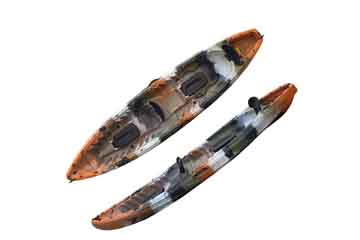7 Things To Know Before Buying A Fishing Kayak
7 Things To Know Before Buying A Fishing Kayak
Fishing kayaks are becoming more and more popular all over the world. Whether it's salt water, fresh water, or north-south water, you can find kayaks in sporting goods stores or fishing gear stores. Even online forums are flooded with pictures of fishermen chasing finned aquatic creatures in fishing kayaks.
Kayaks are lighter and cheaper than traditional fishing boats, and more stable than canoes. They can also be used for small water intake points in urban areas. Therefore, the kayak industry is experiencing an explosive growth of manufacturers. They are producing high-quality fishing kayaks for different applications, from the open ocean to the smallest river.
1. For fishing kayaks, the length is important
The length of the fishing kayak has a great influence on its performance in the water. The first step in determining the length you need is to consider the type of water you will use. Generally speaking, shorter kayaks (less than 11 feet) are more maneuverable, and longer kayaks (over 12 feet) are faster. If your local waters consist mainly of small ponds, streams, and backwaters-choose mobility over speed. If you want to fish in a larger lake, river, or ocean, choose a longer model. It is also important to take your body shape into consideration. If you are 6 feet 5290 pounds, no matter what water you are fishing in, you probably don't want to catch too many fish under 11 feet.
2. Kayak's stability is the key
Although kayaks in the past were notoriously tilted and unstable, many of today's fishing machines are stable enough to stand up, which is unheard of before. For fishing, stability is very important. Too much will reduce the kayak’s flexibility and make it difficult to paddle effectively. If you have a large body, plan to stand up for fishing, or often choose a wider and more stable model for small ponds and rivers. Narrower, more unstable models are easier to paddle and are ideal trollers and anglers, covering large amounts of water in a day.
3. Maximize storage
As fishermen, we have monopolized the market because we have too much fishing gear. Therefore, it is important to find a yak that has enough space to store all the necessities. Some models have integrated storage and even live wells. Others have external storage areas like milk tanks and coolers. Sitting top models usually have molded internal hatches, while sitting models are characterized by storing gears in a more open space in the hull. Make a list of items that you may carry with you when fishing, and imagine where you want to put them before shopping.
4. Is there a keel?
The keel is a piece of "fin"-shaped plastic that is inserted into the water from the hull of the kayak to increase the tracking speed. Some kayaks have an integrated keel, some have a retractable keel, and some do not have a keel. If you are fishing in open waters, fishing, or want to stay in fairly deep waters, choose the keel model because it will allow you to paddle more efficiently. If you are floating on shallow rocky rivers, fishing at close range, or like standing fishing, don't do this.
5. Is there an electronic space?
If you catch a lot of fish in the lake or ocean, this may be something you want to consider. If you are floating on a shallow river, you can also use it.
6. Portability of Fishing Kayak
The disadvantage of all the advancements made in today's kayaks in terms of fishing, stability, and storage is that they are heavier than ever. Take this into consideration when doing research. If you plan to frequently transport your fishing kayak to unknown (and fish-free) waters, you may want something that is light and easy to drag along the dirt road into the lake. If you want to go directly from the truck to the water-rest assured to load up equipment and accessories. Generally speaking, when buying a fishing kayak, the sit-on recreational kayak is much heavier than the sit-in recreational kayak.
7. Anchor or drift
Adding a traditional or electronic anchoring system can be a huge benefit, if you are fishing in open water, or even in stagnant water, you may want to anchor fishing. However, these things also add weight and are unnecessary for anglers who like to drift with the flow while fishing. Do your research well, because there are several fixed methods that fit all budgets.











